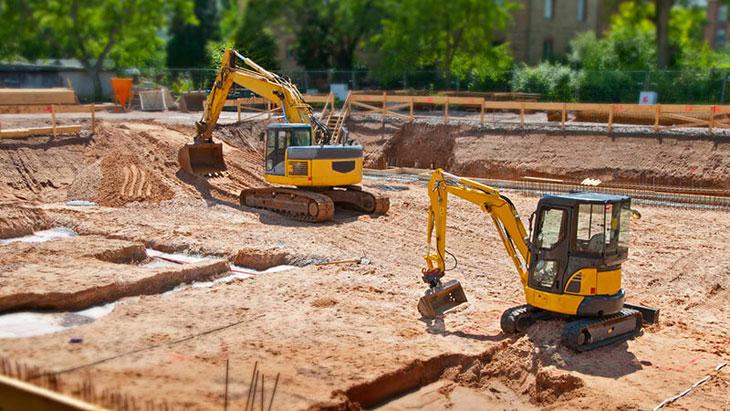Blog

Site Preparation: The Key to a Successful Construction Project
Introduction
Ever wonder what goes into getting a site ready for a new home build? It’s not as simple as just clearing a plot of land and laying down a foundation. The process of site preparation is a crucial first step that sets the stage for the entire construction project. From ensuring a stable foundation to planning proper drainage, every little detail matters when it comes to building a safe, long-lasting home.
In this guide, we’ll break down everything you need to know about site preparation for home contractors. Whether you're building your dream home or working as a contractor, understanding how to properly prepare a site can make all the difference between a smooth construction process and a headache-filled project.
What Is Site Preparation?
Site preparation is essentially the groundwork that needs to be done before construction can officially begin. It involves clearing the land, assessing the soil, ensuring proper drainage, and making sure the area is stable enough to support a structure. While it might sound like just the preliminary work, site preparation is vital for preventing problems down the road.
A well-prepared site ensures that the foundation of your home is secure and won't settle unevenly. It also sets up systems to manage water runoff, protects nearby environments, and meets all necessary regulatory requirements.
Initial Site Assessment
Before breaking ground, an initial site assessment is crucial. This involves surveying the land to understand its unique characteristics. Is the soil rocky, sandy, or clay-heavy? Are there any low-lying areas prone to flooding? Contractors will need to map out the natural landscape to anticipate potential challenges.
If the land is uneven or filled with large rocks, for example, excavation might require more specialized machinery. A thorough assessment helps avoid surprises during construction and provides a clear roadmap for the work ahead.
Clearing and Grubbing
Clearing and grubbing is the next step. In this phase, trees, shrubs, vegetation, and other natural obstructions are removed to make way for the build. It’s not just about aesthetics; clearing the land ensures that nothing interferes with the foundation or the structure itself.
Sometimes, hazardous materials like old building debris, asbestos, or contaminated soil may need to be safely disposed of. Proper grubbing ensures that the site is free of obstacles, allowing for smooth construction work.
Site Excavation and Grading
Once the land is cleared, it’s time to start digging. Site excavation is the process of removing soil to create a level base for the foundation. This step is essential because an uneven foundation can lead to structural issues like cracking or settling.
Grading, which involves shaping the land to promote proper water drainage, goes hand-in-hand with excavation. Good grading ensures that rainwater flows away from the foundation, preventing water damage and erosion.
Soil Testing and Compaction
Before laying the foundation, soil testing is often conducted to ensure that the soil can bear the weight of the structure. Soil with too much clay, for example, can shift and cause foundation problems. Soil testing gives contractors a clear understanding of how to proceed with construction, whether it involves additional support or special foundation techniques.
Compaction is another vital step. Loose soil can shift over time, causing structural problems. By compacting the soil, contractors create a firm, stable surface that reduces the risk of settling.
Utility Planning and Installation
No home is complete without utilities. During site preparation, contractors must plan for and install water, gas, electrical, and sewage lines. Installing utilities during this phase ensures that there won’t be any costly disruptions later in the project.
Coordinating with utility companies early in the process helps ensure smooth installation, and it’s a good time to check that the site layout allows for easy access to these vital services.
Erosion Control and Environmental Considerations
One of the most overlooked aspects of site preparation is erosion control. Construction activities can loosen soil, leading to erosion and sediment runoff into nearby waterways, which can be harmful to local ecosystems.
Installing silt fences or other erosion prevention measures can help keep the site stable and protect the environment. In areas near water sources, it's especially important to take steps to prevent contamination from sediment.
Drainage Systems and Water Management
Proper drainage is critical for any construction site. Water pooling near the foundation can lead to serious issues like basement flooding or foundation cracks. During site preparation, contractors should plan for a drainage system that effectively manages stormwater.
This might involve creating sloped areas or installing drainage pipes to direct water away from the home. Water management isn’t just about preventing damage – it’s also necessary for meeting local building codes.
Permitting and Compliance with Local Regulations
Before any work can begin, contractors must ensure that the project complies with local zoning laws and building regulations. This often involves securing permits for site preparation, grading, and utility installation. Failing to obtain the necessary permits can lead to costly delays, fines, or even legal issues.
Contractors should also work with local inspectors to ensure that the site preparation meets all safety and environmental standards.
Preparing the Foundation Area
With the land cleared and leveled, the next step is to prepare the foundation area. This involves marking out the exact footprint of the foundation, ensuring that it’s level and ready for concrete pouring or other foundation work.
A stable, level foundation is key to the integrity of the home, so this step requires precision and attention to detail.
Temporary Structures and Storage
During construction, contractors often need temporary structures like workstations, storage for materials, or shelters for equipment. These structures should be placed strategically to avoid interfering with ongoing work, while still providing easy access to essential materials and tools.
Temporary structures also play an important role in site safety, providing shelter and organization to keep the project running smoothly.
Access Roads and Site Accessibility
One of the more practical considerations in site preparation is ensuring easy access to the site for heavy machinery and delivery trucks. This often involves creating temporary access roads or driveways that can support the weight of construction vehicles.
These access points should be maintained throughout the project to avoid delays caused by stuck vehicles or damaged materials.
Safety Measures During Site Preparation
Construction sites can be dangerous, which is why safety measures are essential during site preparation. Contractors must follow strict safety protocols to protect workers and ensure that the site complies with OSHA standards.
This includes providing safety gear, securing hazardous areas, and ensuring that heavy machinery is operated by trained professionals.
Conclusion
Site preparation is an often-overlooked but crucial step in home construction. From clearing land to planning drainage and ensuring safety, every task plays a role in creating a stable, secure foundation for a new home. Proper site preparation can prevent costly mistakes, protect the environment, and ensure a smooth construction process.
FAQs
What is the first step in site preparation for a home construction project? The first step is conducting a thorough site assessment to evaluate the land, soil, and potential challenges.
How long does site preparation usually take for a residential project? It depends on the complexity of the site, but most residential projects take a few weeks to complete the preparation phase.
Do I need to obtain permits before site preparation begins? Yes, permits are typically required for activities like grading, excavation, and utility installation.
Why is soil testing important in site preparation? Soil testing ensures that the ground is stable enough to support the home and identifies potential issues with shifting or settling.
What happens if the site preparation isn’t done correctly? Poor site preparation can lead to problems like foundation cracks, drainage issues, or even structural failure over time.
Testimonials

John Doe
Finance Manager
Lorem ipsum dolor sit amet, consectetuer adipiscing elit. Aenean commodo ligula eget dolor. Aenean massa. Cum sociis natoque penatibus et magnis dis parturient montes, nascetur ridiculus mus.

John Doe
Finance Manager
Lorem ipsum dolor sit amet, consectetuer adipiscing elit. Aenean commodo ligula eget dolor. Aenean massa. Cum sociis natoque penatibus et magnis dis parturient montes, nascetur ridiculus mus.

John Doe
Finance Manager
Lorem ipsum dolor sit amet, consectetuer adipiscing elit. Aenean commodo ligula eget dolor. Aenean massa. Cum sociis natoque penatibus et magnis dis parturient montes, nascetur ridiculus mus.

